A study of top marketing agencies reveals the most common mistakes made when it comes to SEO.
from Brian Milners SEO Feed http://tracking.feedpress.it/link/13962/12383334
via IFTTT
I am really excited for the launch of my favorite search engine optimization academy ITTTT SEO V2
A study of top marketing agencies reveals the most common mistakes made when it comes to SEO.
Beyond search Google controls the leading distributed ad network, the leading mobile OS, the leading web browser, the leading email client, the leading web analytics platform, the leading free video hosting site.
They win a lot.
And they take winnings from one market & leverage them into manipulating adjacent markets.
Embrace. Extend. Extinguish.
Imagine taking a universal open standard that has zero problems with it and then stripping it down to it's most basic components and then prepending each element with your own acronym. Then spend years building and recreating what has existed for decades. That is @amphtml— Jon Henshaw (@henshaw) April 4, 2019
AMP is an utterly unnecessary invention designed to further shift power to Google while disenfranchising publishers. From the very start it had many issues with basic things like supporting JavaScript, double counting unique users (no reason to fix broken stats if they drive adoption!), not supporting third party ad networks, not showing publisher domain names, and just generally being a useless layer of sunk cost technical overhead that provides literally no real value.
Over time they have corrected some of these catastrophic deficiencies, but if it provided real value, they wouldn't have needed to force adoption with preferential placement in their search results. They force the bundling because AMP sucks.
Absurdity knows no bounds. Googlers suggest: "AMP isn’t another “channel” or “format” that’s somehow not the web. It’s not a SEO thing. It’s not a replacement for HTML. It’s a web component framework that can power your whole site. ... We, the AMP team, want AMP to become a natural choice for modern web development of content websites, and for you to choose AMP as framework because it genuinely makes you more productive."
Meanwhile some newspapers have about a dozen employees who work on re-formatting content for AMP.
Feeeeeel the productivity!
Some content types (particularly user generated content) can be unpredictable & circuitous. For many years forums websites would use keywords embedded in the search referral to highlight relevant parts of the page. Keyword (not provided) largely destroyed that & then it became a competitive feature for AMP: "If the Featured Snippet links to an AMP article, Google will sometimes automatically scroll users to that section and highlight the answer in orange."
That would perhaps be a single area where AMP was more efficient than the alternative. But it is only so because Google destroyed the alternative by stripping keyword referrers from search queries.
The power dynamics of AMP are ugly:
"I see them as part of the effort to normalise the use of the AMP Carousel, which is an anti-competitive land-grab for the web by an organisation that seems to have an insatiable appetite for consuming the web, probably ultimately to it’s own detriment. ... This enables Google to continue to exist after the destination site (eg the New York Times) has been navigated to. Essentially it flips the parent-child relationship to be the other way around. ... As soon as a publisher blesses a piece of content by packaging it (they have to opt in to this, but see coercion below), they totally lose control of its distribution. ... I’m not that smart, so it’s surely possible to figure out other ways of making a preload possible without cutting off the content creator from the people consuming their content. ... The web is open and decentralised. We spend a lot of time valuing the first of these concepts, but almost none trying to defend the second. Google knows, perhaps better than anyone, how being in control of the user is the most monetisable position, and having the deepest pockets and the most powerful platform to do so, they have very successfully inserted themselves into my relationship with millions of other websites. ... In AMP, the support for paywalls is based on a recommendation that the premium content be included in the source of the page regardless of the user’s authorisation state. ... These policies demonstrate contempt for others’ right to freely operate their businesses.
After enough publishers adopted AMP Google was able to turn their mobile app's homepage into an interactive news feed below the search box. And inside that news feed Google gets to distribute MOAR ads while 0% of the revenue from those ads find its way to the publishers whose content is used to make up the feed.
Appropriate appropriation. :D
Each additional layer of technical cruft is another cost center. Things that sound appealing at first blush may not be:
The way you verify your identity to Let's Encrypt is the same as with other certificate authorities: you don't really. You place a file somewhere on your website, and they access that file over plain HTTP to verify that you own the website. The one attack that signed certificates are meant to prevent is a man-in-the-middle attack. But if someone is able to perform a man-in-the-middle attack against your website, then he can intercept the certificate verification, too. In other words, Let's Encrypt certificates don't stop the one thing they're supposed to stop. And, as always with the certificate authorities, a thousand murderous theocracies, advertising companies, and international spy organizations are allowed to impersonate you by design.
Anything that is easy to implement & widely marketed often has costs added to it in the future as the entity moves to monetize the service.
This is a private equity firm buying up multiple hosting control panels & then adjusting prices.
This is Google Maps drastically changing their API terms.
This is Facebook charging you for likes to build an audience, giving your competitors access to those likes as an addressable audience to advertise against, and then charging you once more to boost the reach of your posts.
This is Grubhub creating shadow websites on your behalf and charging you for every transaction created by the gravity of your brand.
Shivane believes GrubHub purchased her restaurant’s web domain to prevent her from building her own online presence. She also believes the company may have had a special interest in owning her name because she processes a high volume of orders. ... it appears GrubHub has set up several generic, templated pages that look like real restaurant websites but in fact link only to GrubHub. These pages also display phone numbers that GrubHub controls. The calls are forwarded to the restaurant, but the platform records each one and charges the restaurant a commission fee for every order
Settling for the easiest option drives a lack of differentiation, embeds additional risk & once the dominant player has enough marketshare they'll change the terms on you.
Small gains in short term margins for massive increases in fragility.
"Closed platforms increase the chunk size of competition & increase the cost of market entry, so people who have good ideas, it is a lot more expensive for their productivity to be monetized. They also don't like standardization ... it looks like rent seeking behaviors on top of friction" - Gabe Newell
The other big issue is platforms that run out of growth space in their core market may break integrations with adjacent service providers as each want to grow by eating the other's market.
Those who look at SaaS business models through the eyes of a seasoned investor will better understand how markets are likely to change:
"I’d argue that many of today’s anointed tech “disruptors” are doing little in the way of true disruption. ... When investors used to get excited about a SAAS company, they typically would be describing a hosted multi-tenant subscription-billed piece of software that was replacing a ‘legacy’ on-premise perpetual license solution in the same target market (i.e. ERP, HCM, CRM, etc.). Today, the terms SAAS and Cloud essentially describe the business models of every single public software company.
Most platform companies are initially required to operate at low margins in order to buy growth of their category & own their category. Then when they are valued on that, they quickly need to jump across to adjacent markets to grow into the valuation:
Twilio has no choice but to climb up the application stack. This is a company whose ‘disruption’ is essentially great API documentation and gangbuster SEO spend built on top of a highly commoditized telephony aggregation API. They have won by marketing to DevOps engineers. With all the hype around them, you’d think Twilio invented the telephony API, when in reality what they did was turn it into a product company. Nobody had thought of doing this let alone that this could turn into a $17 billion company because simply put the economics don’t work. And to be clear they still don’t. But Twilio’s genius CEO clearly gets this. If the market is going to value robocalls, emergency sms notifications, on-call pages, and carrier fee passed through related revenue growth in the same way it does ‘subscription’ revenue from Atlassian or ServiceNow, then take advantage of it while it lasts.
Large platforms offering temporary subsidies to ensure they dominate their categories & companies like SoftBank spraying capital across the markets is causing massive shifts in valuations:
I also think if you look closely at what is celebrated today as innovation you often find models built on hidden subsidies. ... I’d argue the very distributed nature of microservices architecture and API-first product companies means addressable market sizes and unit economics assumptions should be even more carefully scrutinized. ... How hard would it be to create an Alibaba today if someone like SoftBank was raining money into such a greenfield space? Excess capital would lead to destruction and likely subpar returns. If capital was the solution, the 1.5 trillion that went into telcos in late '90s wouldn’t have led to a massive bust. Would a Netflix be what it is today if a SoftBank was pouring billions into streaming content startups right as the experiment was starting? Obviously not. Scarcity of capital is another often underappreciated part of the disruption equation. Knowing resources are finite leads to more robust models. ... This convergence is starting to manifest itself in performance. Disney is up 30% over the last 12 months while Netflix is basically flat. This may not feel like a bubble sign to most investors, but from my standpoint, it’s a clear evidence of the fact that we are approaching a something has got to give moment for the way certain businesses are valued."
Circling back to Google's AMP, it has a cousin called Recaptcha.
Recaptcha is another AMP-like trojan horse:
According to tech statistics website Built With, more than 650,000 websites are already using reCaptcha v3; overall, there are at least 4.5 million websites use reCaptcha, including 25% of the top 10,000 sites. Google is also now testing an enterprise version of reCaptcha v3, where Google creates a customized reCaptcha for enterprises that are looking for more granular data about users’ risk levels to protect their site algorithms from malicious users and bots. ... According to two security researchers who’ve studied reCaptcha, one of the ways that Google determines whether you’re a malicious user or not is whether you already have a Google cookie installed on your browser. ... To make this risk-score system work accurately, website administrators are supposed to embed reCaptcha v3 code on all of the pages of their website, not just on forms or log-in pages.
About a month ago when logging into Bing Ads I saw recaptcha on the login page & couldn't believe they'd give Google control at that access point. I think they got rid of that, but lots of companies are perhaps shooting themselves in the foot through a combination of over-reliance on Google infrastructure AND sloppy implementation
Today when making a purchase on Fiverr, after converting, I got some of this action
Hmm. Maybe I will enable JavaScript and try again.
Oooops.
That is called snatching defeat from the jaws of victory.
My account is many years old. My payment type on record has been used for years. I have ordered from the particular seller about a dozen times over the years. And suddenly because my web browser had JavaScript turned off I was deemed a security risk of some sort for making an utterly ordinary transaction I have already completed about a dozen times.
On AMP JavaScript was the devil. And on desktop not JavaScript was the devil.
Pro tip: Ecommerce websites that see substandard conversion rates from using Recaptcha can boost their overall ecommerce revenue by buying more Google AdWords ads.
---
As more of the infrastructure stack is driven by AI software there is going to be a very real opportunity for many people to become deplatformed across the web on an utterly arbitrary basis. That tech companies like Facebook also want to create digital currencies on top of the leverage they already have only makes the proposition that much scarier.
If the tech platforms host copies of our sites, process the transactions & even create their own currencies, how will we know what level of value they are adding versus what they are extracting?
Who measures the measurer?
And when the economics turn negative, what will we do if we are hooked into an ecosystem we can't spend additional capital to get out of when things head south?
If you’re in the market for a new web hosting service, HostGator is certainly an option that will come on your radar. It’s a reputable company within the web hosting industry.
Like most web hosts, HostGator has a wide range of plans, options, and hosting types to accommodate the needs of different websites.
Today, I want to put more emphasis on the HostGator Cloud.
Cloud hosting is new compared to other types of web hosting. Rather than your website being hosted on a local server, it’s hosted on multiple remote servers.
One of the biggest benefits of cloud hosting is the ability to scale on-demand. So it’s a great option for fast-growing websites with high volatility in their site traffic.
For those of you who are interested in using the cloud to host your website, I strongly recommend that you review my analysis of HostGator Cloud. I’ll cover their plans, pricing, benefits, and everything else that you need to know before finalizing your decision.

There are three cloud plans offered by HostGator. The cloud uses premium hardware, low-density servers, and multiple layers for caching. As a result, this speeds up your page loading times.
As your traffic increases, HostGator Cloud plans make it possible for you to increase your resources with a click on-demand. All of this happens without any downtime, reboots, or data migrations.
Regardless of the plan you choose, you’ll have access to HostGator’s intuitive dashboard. From here, you’ll be able to monitor all of the metrics related to your website’s performance.
That’s what you’ll use to allocate any additional resources accordingly. Basically, you have complete control of your usage with the HostGator Cloud.
Let’s take a closer look at each individual cloud hosting plan.
The Hatchling Cloud is the entry-level cloud hosting plan from HostGator. It’s made for hosting one domain and has 2 GB of RAM.
Like all cloud plans, the Hatchling comes with a free SSL certificate.
Pricing for this plan starts at $4.95 per month as an introductory offer. Your contract will renew at $8.95 per month.
You can add on SiteLock monitoring, CodeGuard site backups, professional email, and HostGator SEO tools for additional annual fees.
This plan is best for new websites that want to be hosted on the cloud. Even though you can allocate new resources on demand, you’ll likely want to upgrade as your total monthly traffic increases.
Here’s a quick glance at what the Baby Cloud offers compared to the Hatchling.
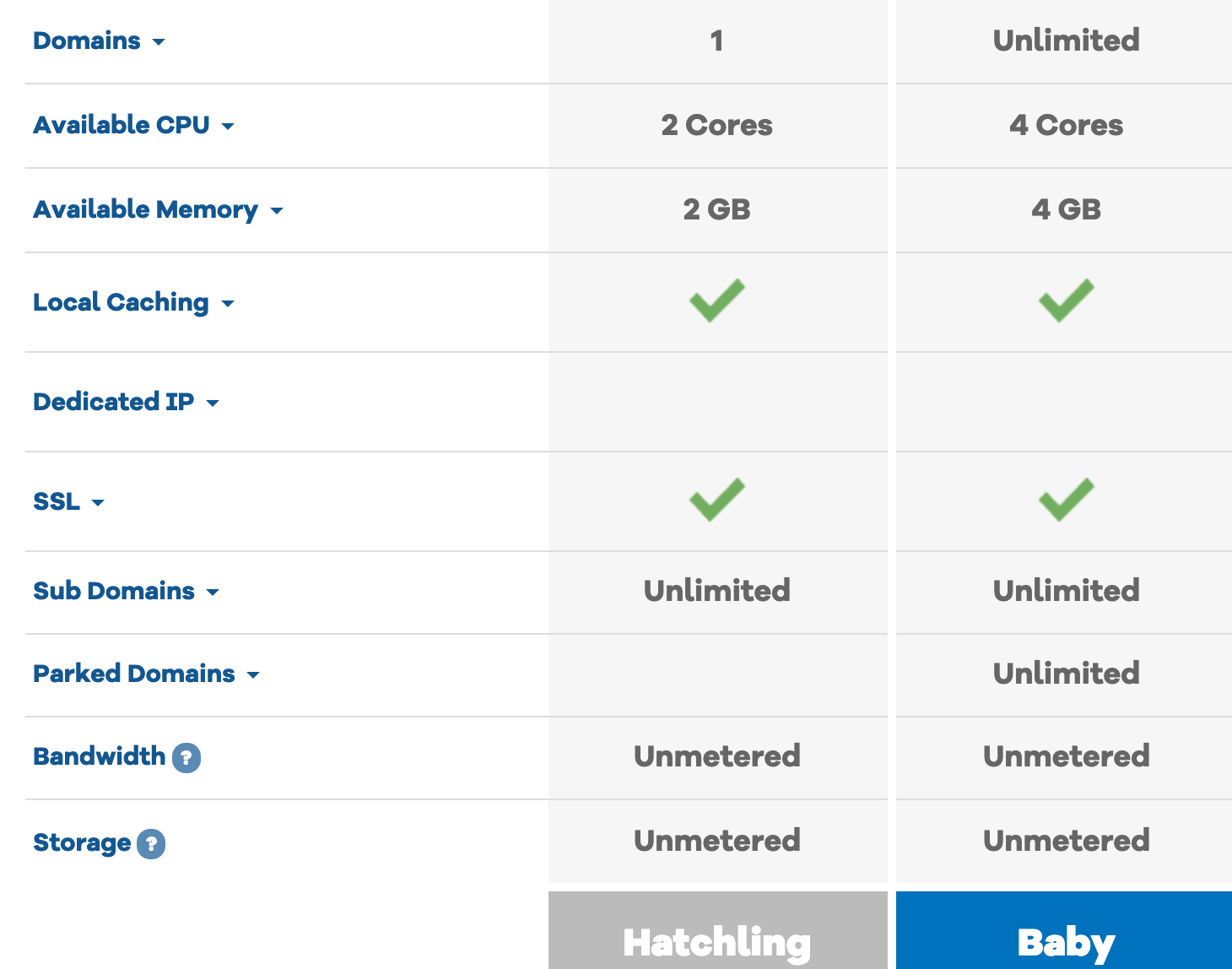
As you can see, the Baby Cloud can host unlimited domains, and has twice as much available CPU space, and double the memory.
The rate for new cloud customers is $7.95 per month, before renewing at $11.95 per month. Right now they’re running a deal where you can actually get the introductory rate reduced down to $6.57 per month, which is a great value.
All you need to do is sign up and the discount will automatically be applied at the checkout.
This is the most popular cloud hosting plan offered by HostGator. I’d say it will likely be the option that’s the most suitable for the majority of you.
The Business Cloud is HostGator’s top-tier cloud hosting plan. Like the Baby Cloud, it also hosts an unlimited number of domains on a single plan.
However, the Business plan comes with access to 6 cores, as opposed to just 2 or 4 cores on the Hatchling and Baby plans. Your HostGator Business Cloud also has access to 6 GB of RAM.
It’s the only cloud hosting plan that comes standard with a dedicated IP address. This feature is not available on the Hatchling plan and it costs an additional $4 per month on the Baby Cloud plan.
Considering that the Business Cloud starts at $9.95 per month, that extra feature is a great value. However, it’s worth noting that renewals jump up to $17.95 per month once your initial contract expires.
While the primary focus of this review is on the HostGator Cloud, I would be doing you a disservice if I didn’t mention the other hosting options offered by this provider.
Cloud hosting isn’t for everyone. So if you’re in the market for a more traditional type of web hosting plan, you may want to consider one of these options as an alternative.
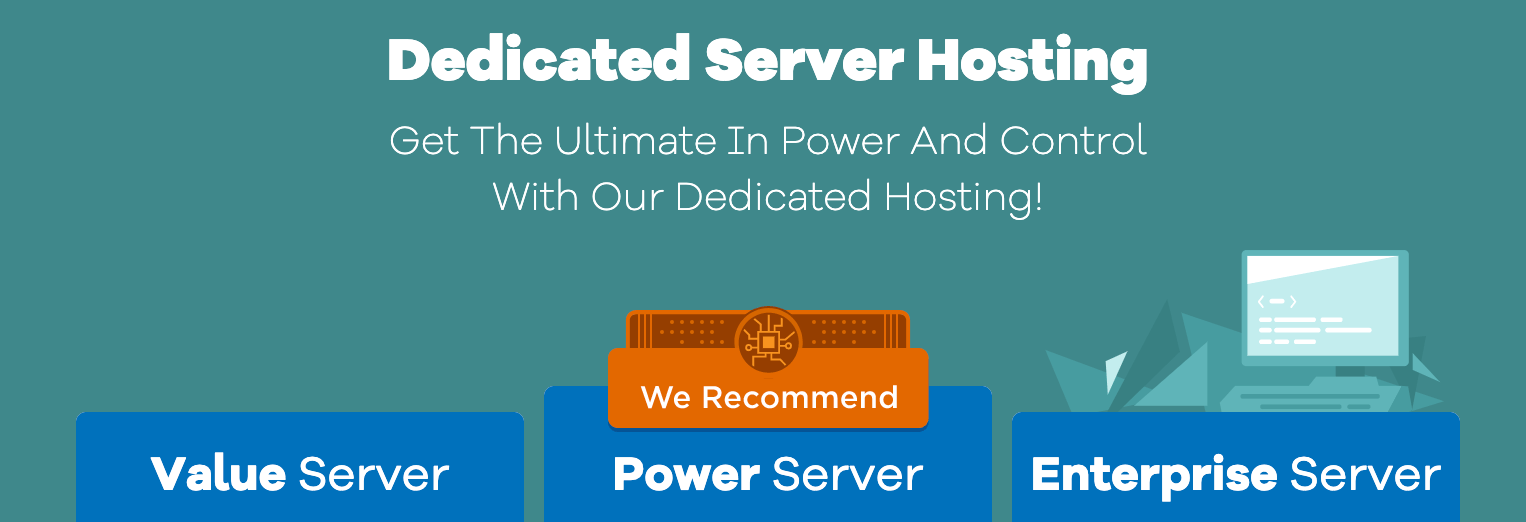
With a dedicated server, your website will be renting a physical server from HostGator. This server will only be used for your site.
It’s a faster option than shared or VPS hosting since you won’t be sharing any resources, storage, or bandwidth with other websites.
Dedicated servers are ideal for those of you who are a bit more tech-savvy. If you want complete control over your server in terms of security and flexibility, this is your best bet.
Pricing for HostGator dedicated servers starts at:
Compared to the cloud hosting plans, these dedicated servers are priced significantly higher.
Virtual private servers from HostGator give you flexible software options. You’ll gain full root access, which gives you added control in your environment.
The VPS plans are a step up from shared hosting, but not quite as in-depth or expensive as the dedicated servers. For comparison purposes, let’s take a look at how these VPS plans are priced, so you can weigh them as an option against cloud hosting.
If you’re already using cPannel for web hosting, SiteGround will migrate you to VPS hosting for free.
If you’re on a budget and don’t want to use the cloud, shared hosting is the bottom-tier plan offered by HostGator.
Plans start at $2.75 per month, $3.95 per month, and $5.95 per month, respectively.
The problem with this option is that you’re going to be sharing resources with other websites. So if those sites have traffic spikes or higher volumes of visitors, it will impact the metrics on your site as well.
So if you want to save some money, but don’t want to sacrifice performance, cloud hosting will be a better option for you. Shared hosting doesn’t give you the flexibility to manage your resources the way that cloud hosting does.
Now that you’ve had a chance to see some of the other types of web hosting offered by HostGator, let’s get back to focusing on the HostGator Cloud.
The following benefits refer specifically to the cloud plans. So for those of you who are considering one of those alternative options, I can’t guarantee the same advantages.
When measuring the performance of a web hosting service, uptime and page loading speeds are two of the most important metrics to consider. Let’s take a look at how a HostGator Cloud test website performed so far this year.
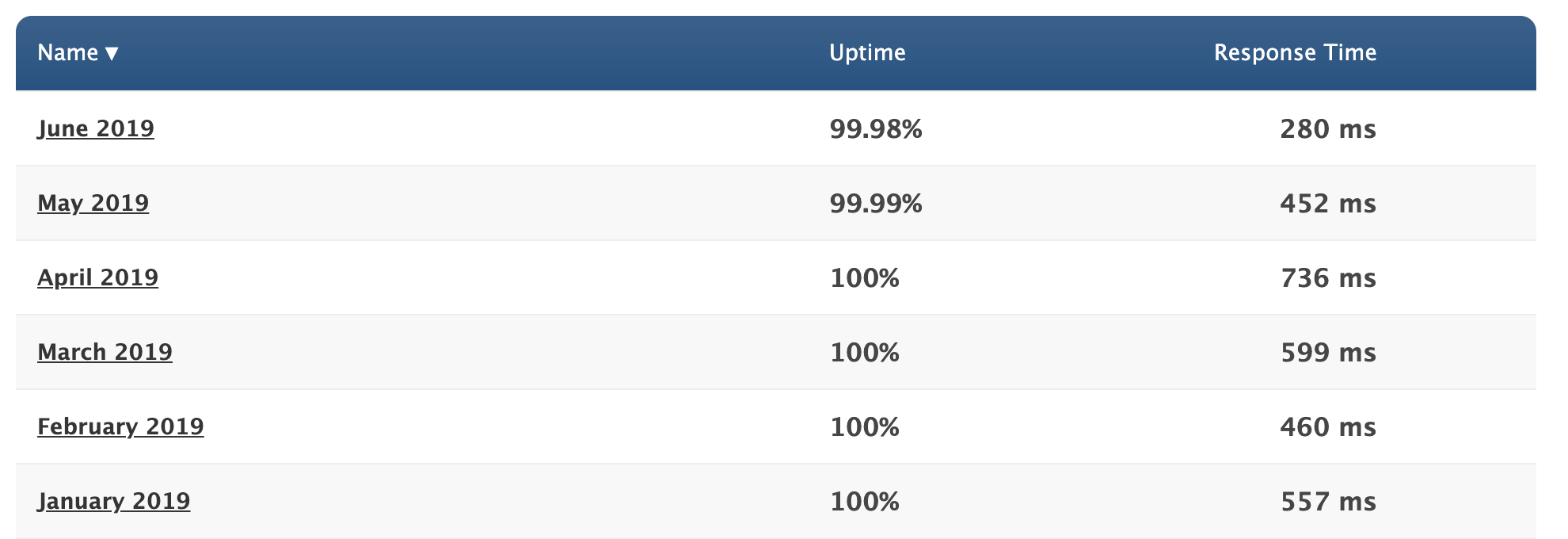
Over the past six months, HostGator Cloud had a 99.995% average uptime rate. That’s about as exceptional as it gets.
As you can see from the table above, the page loading speed fluctuates quite a bit so far this year. The fastest average monthly response time was 280 ms, while the slowest was 736 ms. But on average, the response time in 2019 is 514 ms.
Truthfully, it’s definitely not the fastest loading time we’ve seen. But with that said, it’s still very fast, and far from the slowest.
Based on these numbers, I can’t say that you’ll be disappointed with your uptimes or loading speed if you decide to go with a cloud hosting plan from HostGator.
HostGator Cloud is very easy to use. It’s a great option for beginners, as well as users who have more experience with web hosting.
The cloud plans make it possible for you to allocate your resources as needed whenever you’re experiencing traffic spikes. That’s not the case with their other plans, which would require you to upgrade as you reached limitations on resources.
Even if you’ve never done this before, the interface is very easy to manage.
Another reason why HostGator Cloud is so user-friendly is because you won’t have to worry about outrageous pricing. These plans don’t surprise you with monthly overage fees when you exceed your plan limits. That’s a major downside of other web hosting plans.
The reason why cloud hosting from HostGator is so fast is because it doesn’t rely on typical servers. Instead, the servers from remote data centers work in unison with a person’s web browser to limit the number of resources required to host the website.
Things like managed cloud resources, data mirroring, and integrated caching make this possible, which comes free with your cloud hosting plan.
Furthermore, you’ll get free server monitoring to alert you if there are any hardware problems.
When you sign up for HostGator cloud, you’ll have access to cPannel as well. As I said before, you’ll get a free migration if you’ve been using cPannel with your current web host.
HostGator Cloud comes with 24/7/365 customer support, which is crucial for web hosting. My favorite part about this is their support portal.
Rather than having to pick up the phone or chat online, there’s a good chance you can find the answer to your question here.
Here’s an example of a tutorial that explains the step-by-step process of how to add resources to your cloud hosting plan.
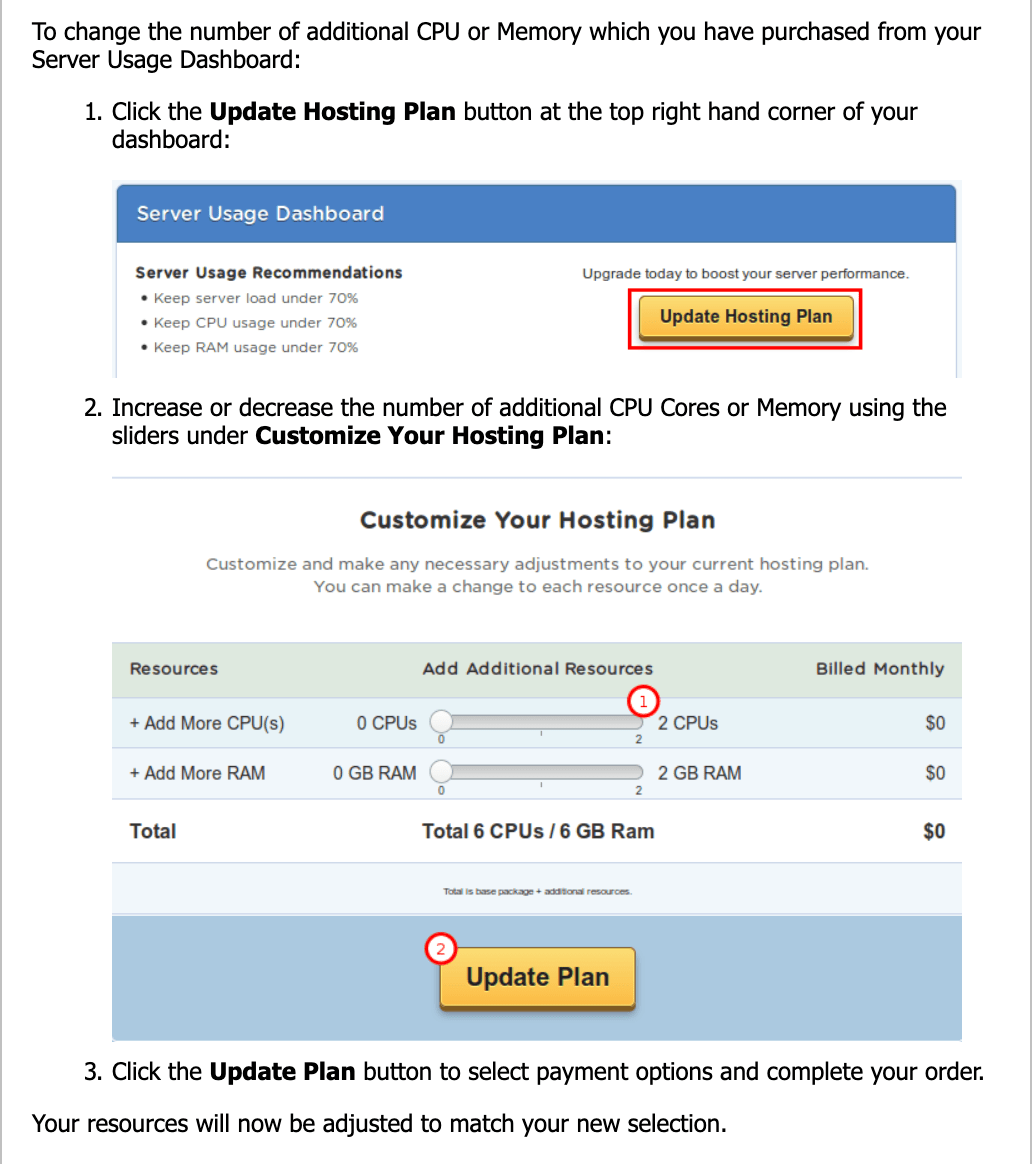
HostGator has tons of these for nearly every aspect of cloud hosting. It’s a quick way to find a solution to your problem.
With that said, phone support and live chat is always available as well. Personally, I prefer live chat as opposed to picking up the phone. But you’ll have both options depending on your personal preference.
Based on the benefits that we just discussed, I think we’ve established that HostGator Cloud is a top choice to consider if you want to use cloud hosting. But with that said, there are a couple of things that you need to keep in mind before you make that decision.
I briefly touched on this earlier when we discussed the cloud hosting plans, but the initial rates are just introductory offers. When your contract renews, you’ll be paying more.
Depending on your plan, you can expect prices to increase by roughly 80%.
While HostGator has its fair share of freebies, there are also some upsells along the way as well. Some of these are automatically checked off in your shopping cart, so make sure you review that page thoroughly before you commit to anything.
Overall, HostGator is a reputable name in the web hosting space. Their cloud hosting service is a great option for those of you who want to take advantage of cloud website hosting.
If you compare those plans to their standard shared hosting options, the cloud is the superior choice in my opinion.
However, if you don’t think cloud hosting is for you then you could always consider VPS or dedicated server hosting from HostGator as well.
For those of you who still aren’t convinced on the HostGator Cloud, you can check out my list of the best web hosting services for some other viable options.
how I went to number one on Google for a competitive term by just getting people to click my page
Google's John Mueller recently offered advice on migrating to a different web platform with minimal impact on SEO.
the best old-school spam linking tool there is today
Anyone can create a website. Just because you own or manage a website, it doesn’t automatically mean that you’re a natural born designer.
But the design and layout of your website will have a huge impact on its success.
In fact, 48% of people say that the design of a website is the top factor they use when it comes to determining how credible a business is. 38% of people will stop using websites with unattractive layouts.
So if you want to create unique and beautiful landing pages without having to design them from scratch, you’re going to want to use pre-designed templates. WordPress is the best place to find these.
That’s because WordPress is the most popular CMS platform in the world, and has been for the past seven years in a row.
It controls nearly 60% of the entire CMS market across the globe. With more than 500 new sites launching on WordPress each day, it’s also the fastest growing CMS worldwide. 34% of the whole internet is run via WordPress.
So if you were on the fence about using WordPress to manage your site, hopefully now you’re convinced.
For those of you who are already using WordPress, you’re ahead of the game. Now it’s time to design the best landing pages for your WordPress site.
With so many options to choose from, I’ve narrowed down the top 11 WordPress landing page templates to make the decision much easier for you.

Landkit is extremely easy to use, yet it’s designed for high performance. The hybrid composer page builder makes it possible for you to design your website without having to write any code.
It doesn’t use many server resources, which makes it perfect for websites with high volumes of traffic. You can use the Landkit template to functionally present information in a way that’s attractive to your website visitors.
Another reason why I recommend Landkit is because the landing page templates are so versatile. They can be used for pages related to things like:
The list goes on and on. Landkit makes it easy for you to change the colors to match your website color schemes. It’s also compatible with the WooCommerce plugin, for those of you who are using WordPress for your ecommerce site.
Landkit has more than 70 page elements for complete customization. You can choose from 12 header styles, and add use the built-in WordPress mega menu. This landing page theme can be purchased for $49.
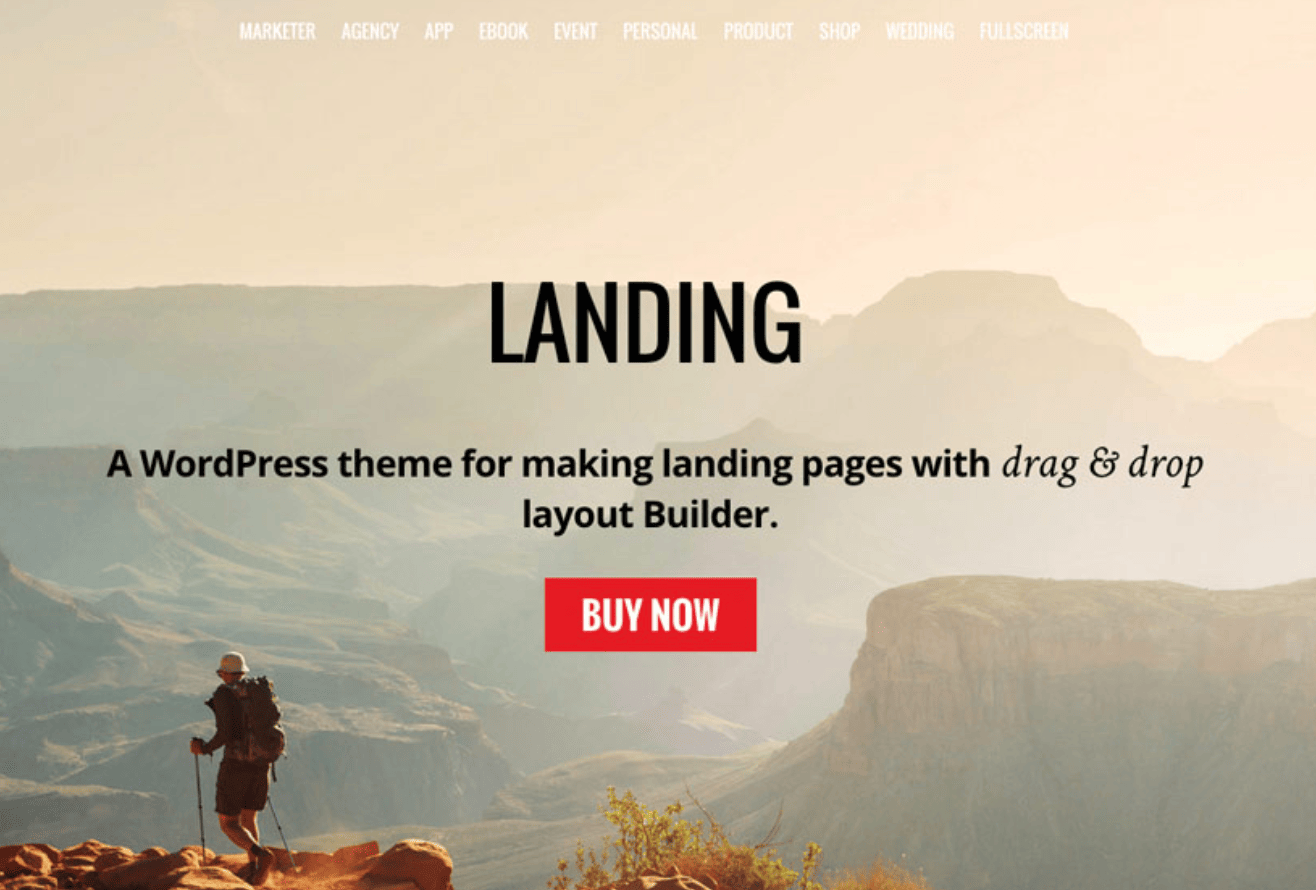
The Landing template from Themify is another versatile option for you to consider. It comes with a drag and drop page builder, making it easier than ever before to customize all of the page elements to your liking.
Landing has more than 25 builder layouts for you to choose from, based on the type of page that you want to create.
There are options specifically created for products, portfolios, marketers, events, ebooks, weddings, agencies, restaurants, mobile apps, personal pages, and more.
I like this template because it has a responsive design on all devices, and it’s retina ready as well. Landing has cool header options such as:
These choices are ideal for those of you who want to draw more attention to background images and CTAs on your landing page. Another benefit of Landing is the fact that it has MailChimp integration, so you can use this landing page to collect email addresses.
The standard Landing WordPress template costs $59. Developers can buy it for $69.

BeOnePage Lite is meant to portray a futuristic and interactive design. This template can be customized to be colorful as well. It comes with a full-screen layout and slider that can be used to display things like images, videos, icons, and other graphics.
Another benefit of this template is that it can support several different media files. The parallax effect of BeOnePage Lite ensures that all scrolling will be very smooth on the user’s end.
It has a responsive design, with lots of customizable options for you to consider. BeOnePage Lite is a retina ready template that can be used as a landing page for virtually any website.
So if you’re looking for a modern WordPress template that’s free to install, BeOnePage Lite should be taken into consideration.

Foton was developed with software and mobile app promotion in mind. So for those of you who are creating a landing page to drive mobile app downloads or sell software, this template should be at the top of your list.
You can import this template into WordPress with just one click. To customize your page settings, you can take advantage of the drag and drop page builder, which is extremely easy for anyone to use.
No coding is required to use Foton. It has WooCommerce integration, slider revolution, and excellent support. It’s also fully responsive and easy to change color themes.
Foton comes with free plugins and is optimized for SEO purposes. It has shortcodes designed for portfolios as well, such as lists, projects, sliders, galleries, masonry, and hover layouts.
Transitions from page to page are very smooth. The font sets and icons are attractive and easy to change as well. Shortcodes for videos and call-to-actions are definitely ones that you’ll want to take advantage of.
The Foton WordPress landing page template is priced at $59.
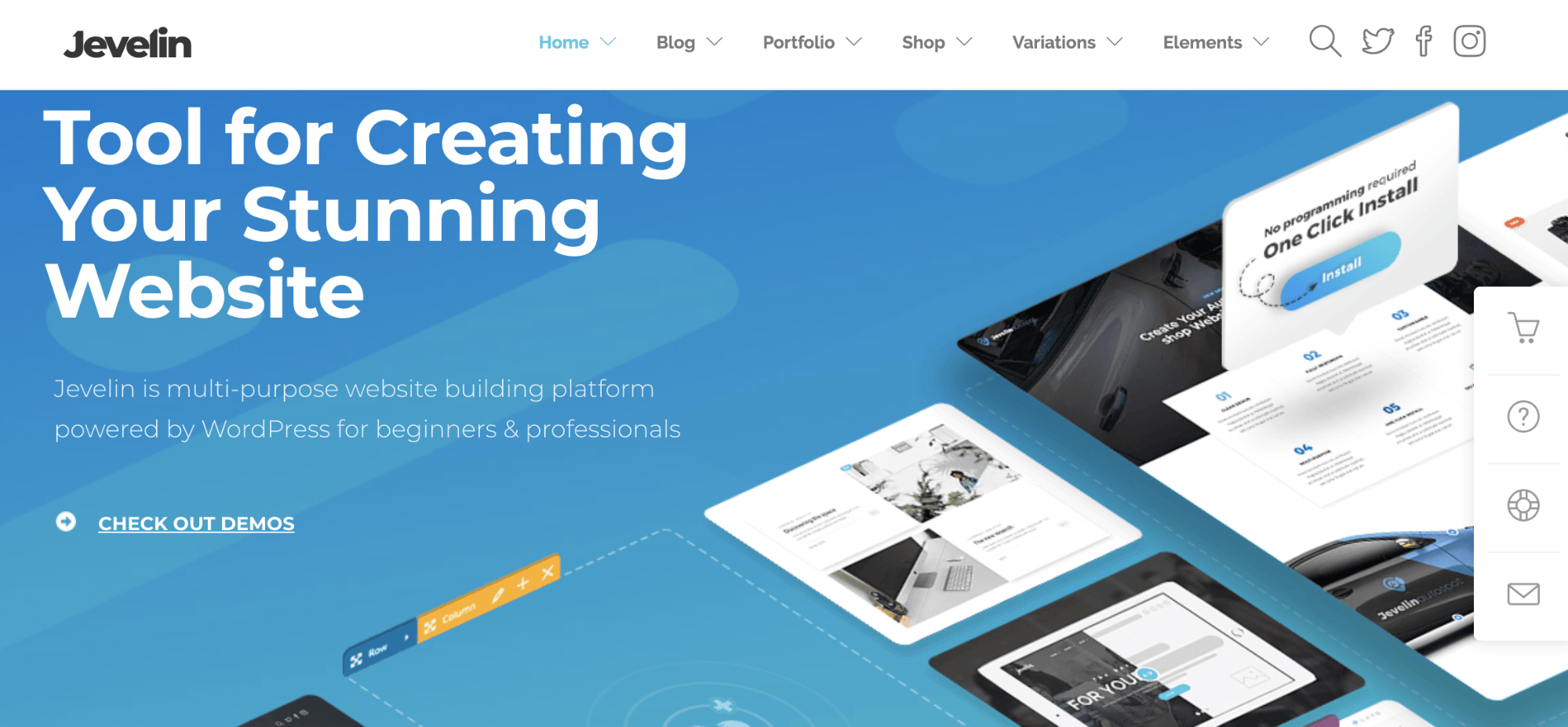
Jevelin is another multi-purpose WordPress landing page template. Some of the top features of this theme include:
There is a great video installation guide, making it possible for anyone to install Jevelin, even if you don’t have experience adding landing page templates to your WordPress site. The fact that it has built-in capabilities with one of the best WordPress form plugins is another added bonus.
Jevelin has great reviews from website owners who are using this template on their sites.
The drag and drop builder paired with mega menus, custom widgets, social sharing functionality, and ecommerce support make it a popular option. This WordPress landing page template can be bought for just $59.

Launchkit is definitely a one size fits all landing page template, which I’m not saying in a negative way by any stretch. I like Launchkit because it can be used for virtually any landing page for any business type.
They offer versatile headers with all different types of media in mind. You can customize headers, CTAs, and forms in a way that positions them for high conversions.
Launchkit has simple colors, so your website always looks good, regardless of the screen size or type that it’s being viewed on.
Top features of Launchkit include:
This template comes with more than 600 Google Fonts as well. With that in mind, you should check out my guide on the best Google Fonts that go together on your website.
For the reasonable price of $59, Launchkit is definitely one of the best landing page templates you can find for your WordPress site.
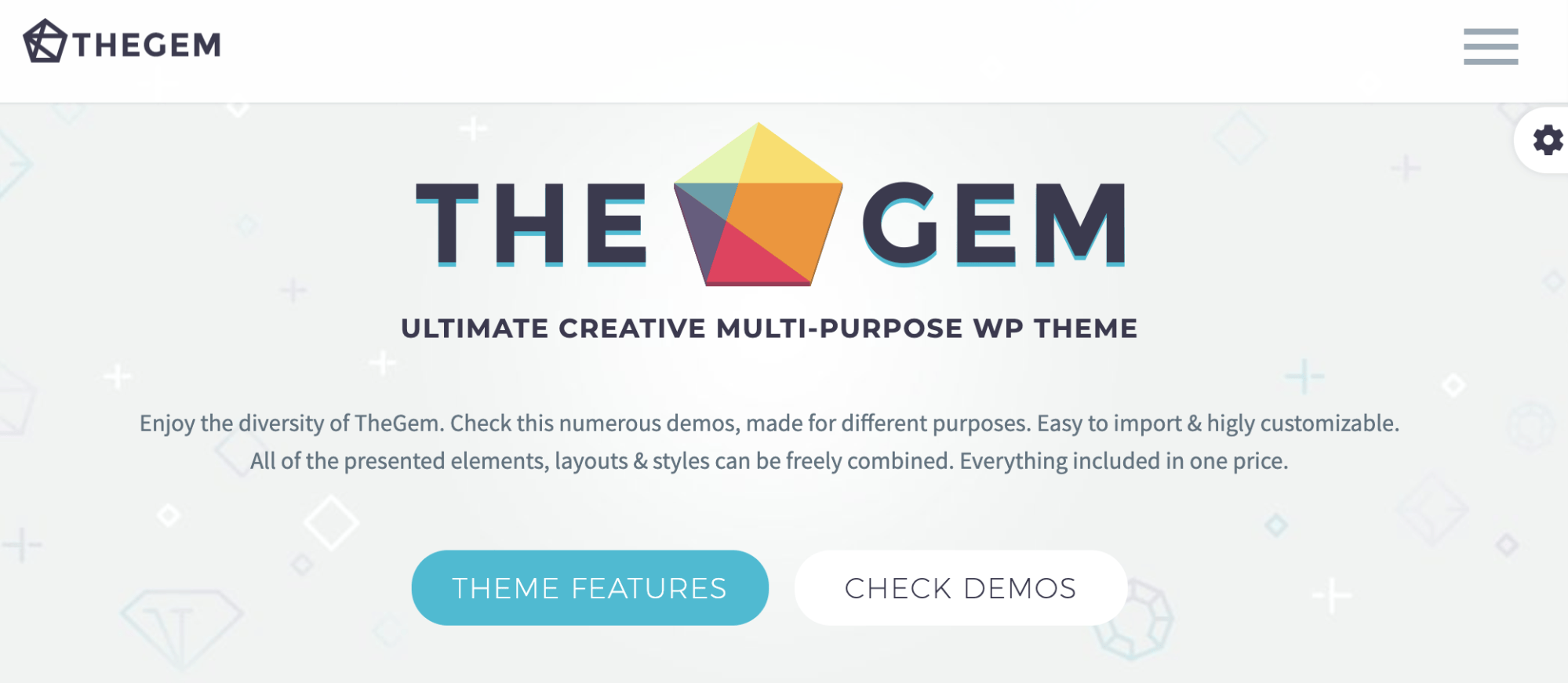
If you’re looking for a multi-purpose landing page that is optimized for high performance, look no further than The Gem. This template offers a creative design that’s modern and suitable for all different types of websites.
There are more than 70 built-in concepts. So you can find a landing page that fits your needs.
These are just some of the many options that showcase the versatility of this WordPress landing page template. It’s fully responsive and looks great on both desktop devices and mobile screens.
The Gem is compatible with WooCommerce, making it a top choice for those of you who have an ecommerce shop.
With the visual composer, you can easily change elements on your landing pages with the drag and drop builder. The template is compatible with plugins and also comes with premium sliders.
You can buy this landing page template for $59.
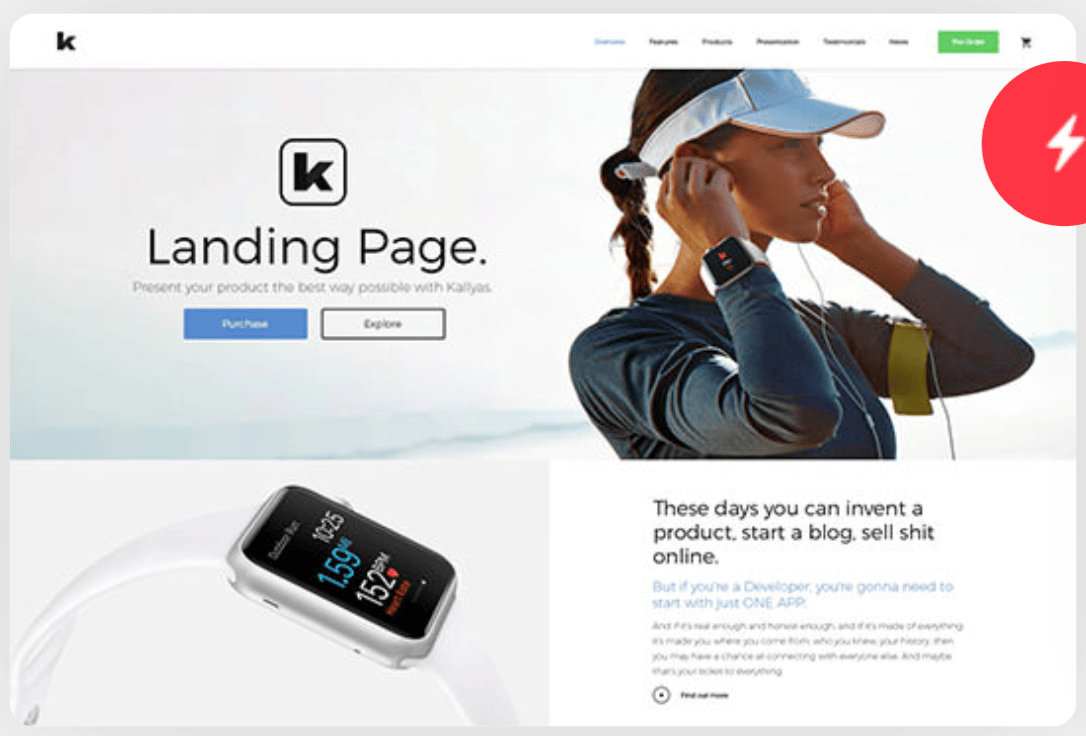
More than 35,000 websites are using Kallyas for landing page templates. They have more than 65 live demos, with new ones coming out each month.
I always like it when landing page templates offer lots of live demos because it makes it easier to give you inspiration for designing your own website. Top benefits of Kallyas include:
The one-click installation makes it easy for you to start editing your website in minutes. They have demos for things like weddings, makeup artists, bloggers, kids websites, membership sites, news, medical, sports, and dozens more.
Kallyas has more than 100 pre-built elements into the template. This gives you seemingly unlimited options when it comes to customizing your landing pages. Kallyas is priced at $69.
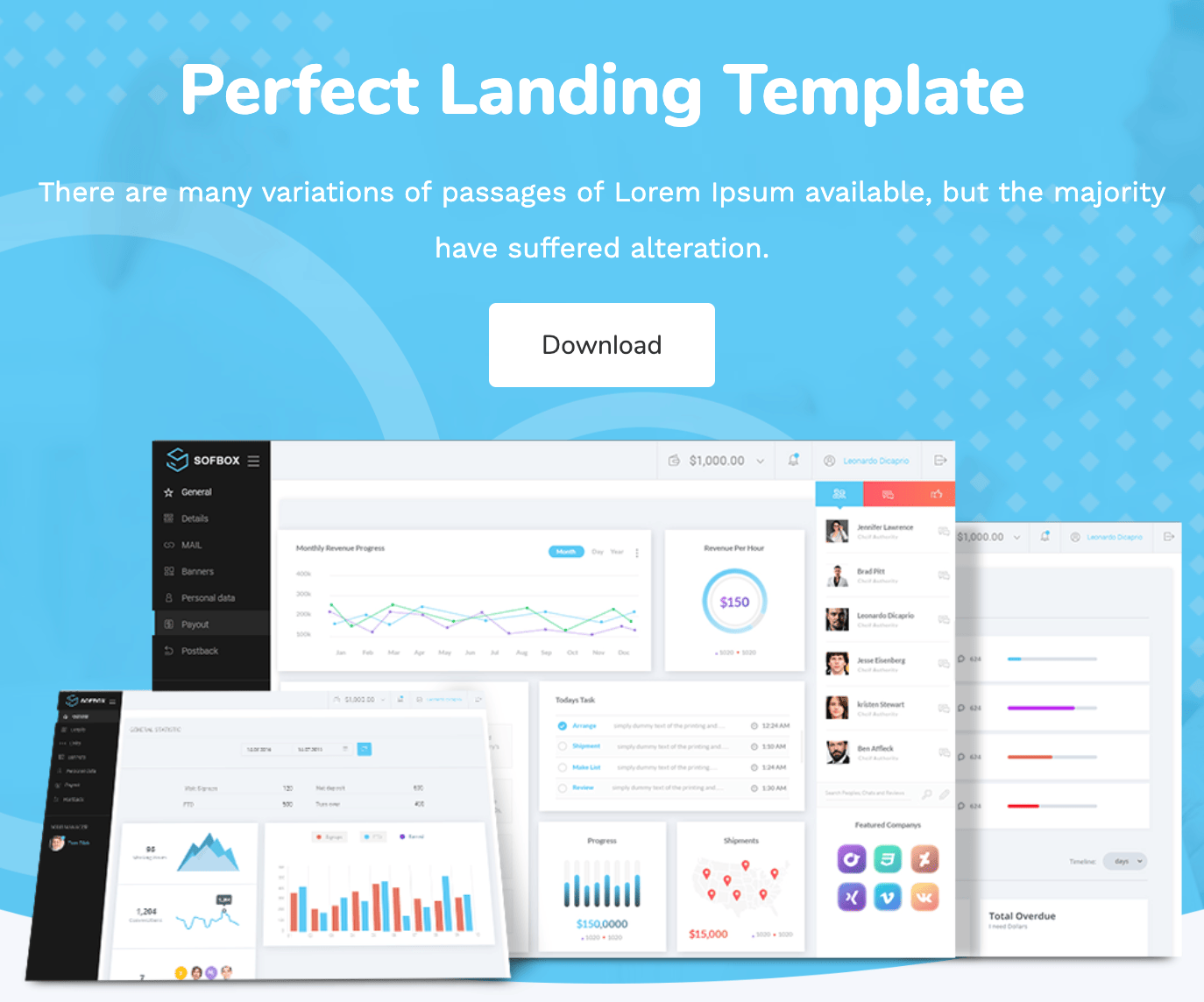
Softbox is perfect for those of you who want a clean and professional design for landing pages on your website. It’s easy to choose your layout and customize the elements with some of their pre-built options.
It works on all major web browsers, screens, and devices. Softbox is retina ready and fully responsive. They have templates designed specifically for home pages, blogs, and interior landing pages as well.
In a word, Softbox can be described as simple. But when it comes to your website, simple designs have higher conversion rates.
Compared to some of the other WordPress landing pages on our list, Softbox is offered at a lower price point. This template can be yours for just $39.
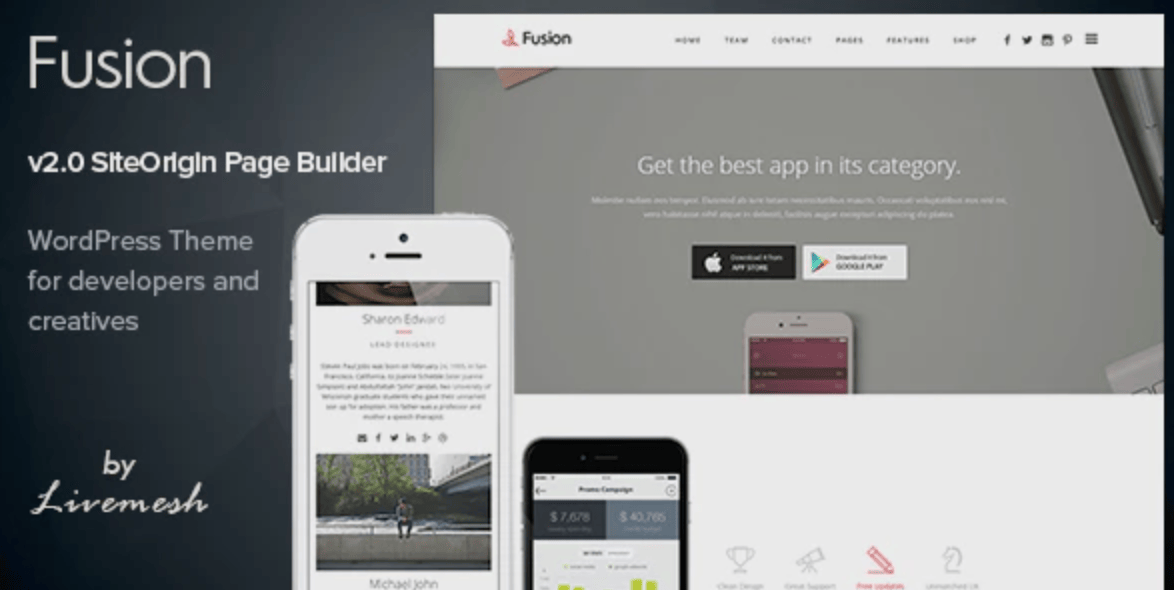
The Fusion WordPress template is designed with mobile app landing pages and portfolio landing pages in mind. So if you’re looking to showcase one or both of these things on your website, you should take a closer look at this option.
It’s an ideal solution for agencies and developers. The pages can be set up so that creatives can showcase their products. This holds true for both firms or individuals as well.
The typography is super clean. All of the design elements and whitespace is managed perfectly with this template, so the eyes of your website visitors are always drawn to the right spot on the page.
Fusion has a simple shortcode builder and easy customization. Everything integrates seamlessly into WordPress for you to manage.
This template has more than 1,500 retina icons, a revolution slider, and the ability to create a gallery with captions. It comes with over 500 Google Fonts, Contact Form 7, and an Ajax loading gallery as well.
Fusion costs $49 to install.
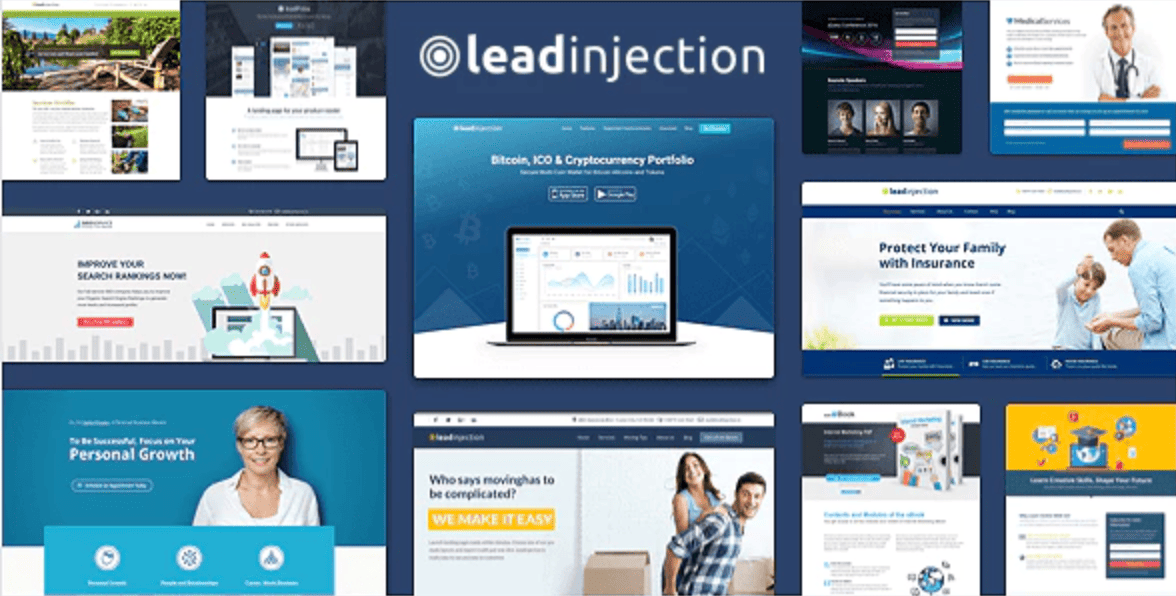
Last, but certainly not least, on our list is Leadinjection. As the name implies, this template is designed especially for generating leads.
They have pre-built layouts for things like:
As you can see, these lead generation templates are extremely versatile and can fit the needs of nearly any website.
The template comes with a Lead Modal plugin, that’s basically a popup on your site that can be used to generate leads. This can be based on timing, exit intent, or other trigger options.
Leadinjection has all different types of opt-in forms for your landing pages as well. You can fully customize your CTA, and even add a click to call button for your mobile site. If this sounds like the landing page template that you want, it can be purchased for $39.
If you need help designing a landing page for your WordPress website, I’m confident that you can find what you’re looking for somewhere in these options that I’ve listed above.
I tried to include something for everyone on here. Some of these templates are made for multiple purposes, while others are made specifically for things like mobile apps, ecommerce, or lead generation.
Price is another factor that you can take into consideration when making this decision. While there are some free WordPress landing page templates, the rest tend to be priced between the $39 and $69 range.
So keep this list in mind when you’re on the search for the perfect WordPress landing page template.
how I went to number one on Google for a competitive term by just getting people to click my page
the best old-school spam linking tool there is today
There are nearly 1.7 billion websites worldwide. This number continues to grow each day.
What do all of these sites have in common? In one way or another, they all use some form of HTML. That’s why learning basic HTML is such a useful skill.
Here’s the thing. You can definitely build a website without having to write a line of code. But with that said, once your site is live you should still know how to read and some HTML on your own.
So whether you’re creating a new website, have an existing website, or you just want to learn more about coding, this is guide will serve as the perfect introduction to HTML for you.
Let’s start with the basics. What exactly is HTML?
This acronym stands for Hypertext Markup Language. Basically, it’s the standard format used to create web pages, web applications, and documents. This computer language is a series of code that is typically written in a text file and then saved as HTML. When viewed on a web browser, this code translates to a properly formatted blend of text and other media.
HTML is behind every web page you see online, including this page that you’re reading right now.
As I’ve already mentioned, HTML stands for hypertext markup language. But those words don’t mean much to most people, so I want to break them down even further so you can fully understand the definition.
The word hypertext dates back more than 50 years. It was invented to describe links in a document that make it possible for a viewer to jump to another place in the document or to a completely new document. This is something that we see and use every day in the modern Internet.
Here’s a visual representation of what hypertext looks like.

I’m sure you’re familiar with hyperlinks, which is a form of hypertext.
As you browse online, you’ll see either http:// or https:// before every web page in your web browser. This stands for hypertext transfer protocol.
Markup language refers to how documents and web pages are displayed. You see words that are bold, italic, or larger on a page. But behind the scenes, the markup language is the reason why certain components appear differently on a page.
Markups are characterized by tags and attributes. Most of the time these tags come in pairs. There are start tags and end tags, which are also known as opening tags and closing tags.
HTML is the default language for all websites on the Internet. But it’s also used for various types of documents, such as ebooks.
When an HTML document gets rendered by a web browser, all of the markup language and tags are hidden. The display automatically gets changed to display a reader-friendly version of the document (what you’re seeing right now).
Do you need to learn HTML to create a website?
The short answer is no. Unless you’re planning to build pages from scratch and pursue web development, you won’t necessarily need to know every single component of HTML.
You can probably get away without knowing HTML if you’re using a CMS, website builder, or blogging platform. For example, if you’re using WordPress as your blogging CMS, the visual editor automatically translates your text to HTML.
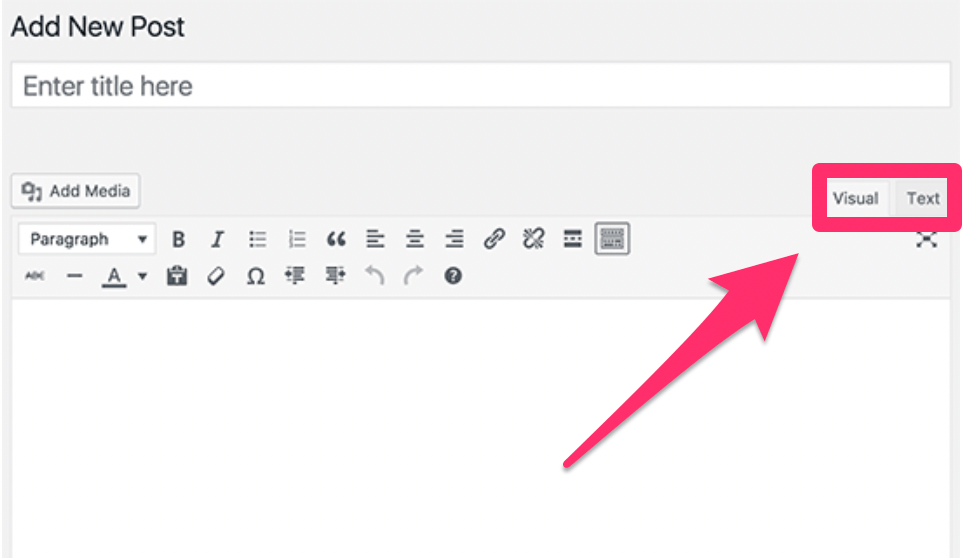
Working in the visual editor will display content similar to a standard email message or Microsoft Word document.
With that said, there are times when visual editors don’t always work the way you want to. You might find yourself in a situation where you want to format something a certain way and it’s not getting displayed properly.
Furthermore, your HTML also needs to be optimized for non-human readers. Search engine bots are crawling your website for indexing purposes. The way that your HTML gets read will have an impact on your SEO.
Website accessibility also needs to be taken into consideration. Computers can translate web pages into sound for people with disabilities. They rely on the structure and quality of HTML for this.
While the platforms on the market today make it possible to operate a website without knowing HTML, it’s still in your best interest to learn the basics.
For those of you who are planning to create web pages using HTML, you’ll need to use an HTML editor.
These editors are the best way to organize your code and keep everything clean. Editors are great because they recognize whenever a new tag is opened. These tags are automatically closed by the software, ensuring that your code doesn’t have bugs. This also limits the number of typing and keystrokes you have to make.
The best HTML editors let you preview your HTML to see how the content will look from a web browser. There are tons of options online. But I’ve narrowed down a handful of the top HTML editors for you to consider.
You can also practice HTML with this free tool from W3Schools. That’s what I’m going to use to show you examples of HTML as we continue.
Before you start writing HTML, you need to understand the three main components.
These can be described as the building blocks or foundation of HTML. Once you learn what these are and how they work, it will be easier for you to move forward. I’ll go into greater detail on each of these below.
In short, tags are used to distinguish HTML code from normal text. The way your document gets displayed will be based on the tag instructions.
Here’s an example. Let’s say you want to make something bold.

The tag for bold is <b>, which is pictured above. This compares to the text above it, which is <p>, or a standard paragraph text.
Once the code is rendered, it’s displayed how we would normally see it on a web page, as you can see from the right side of the screenshot above.
Now let’s say you wanted to make something italicized. The HTML tag would look like this:

Pretty straightforward, right?
All I’m doing is using the tags to change the way the text appears when it’s on a web page.
Take a look at those tags closely. Do you notice a difference between the opening tag and closing tag? The closing tags have a slash, indicating that the italics, bold, or whatever other tag you’re using stops here.
If that example above didn’t have a slash in the closing tag, anything written after it would continue to be italicized.
Hyperlinks are also created with tags. Here’s what the HTML tag would look like if I wanted to hyperlink to the Quick Sprout homepage.

This tag is a little bit more in-depth than the bold and italics examples. But the same concept still applies.
There is an opening tag and closing tag with text in between. The way these tags are written determines what the result will look like on the web page.
Every web page starts with a <!DOCTYPE html>. Then the first line of the file says <html> as well. You can see this on the three examples that I showed you above. This tells browsers how to read the code.
An HTML element consists of the opening tag, closing tag, and the content in between the two.
So when we were going through different examples of tags, each example was a new element. For example, let’s take a look at some potential lines of HTML.
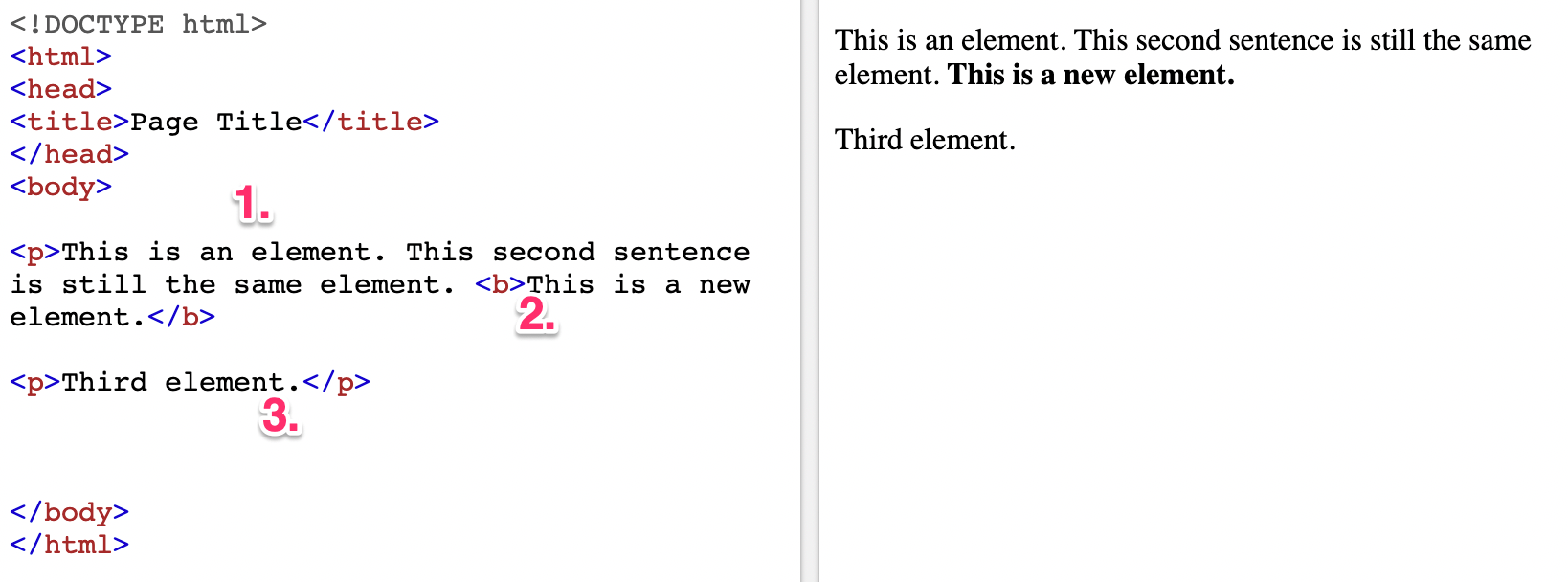
When you look on the right side of the screen at the page version of this code, you see four total sentences and two paragraphs.
Now, look at the HTML code on the left side of this split screen. You can see how the three different elements are identified.
Elements can be simple, such as the bold example above, or they can be a bit more complex.
The document above starts with an open <body> tag, and also ends with a closed </body> tag. So everything within those two tags can also be considered one element. But within that entire body, there could be dozens, hundreds, or thousands of additional elements, depending on how long and complex your content is.
For the most part, tags are used to define how content is displayed in HTML. But with that said, there are times when additional information within an element needs to be added.
In these instances, you would use an attribute to define a specific characteristic of the element in question. Attributes consist of two things:
They are placed inside the start tag of an element. Here’s an example to show you what I mean.

The attribute used here is align=”center” and it falls within the <p> opening tag. It means that whatever text comes before the closing </p> tag will have a specific characteristic defined by the attribution.
In this case, the attribute said to center the text.
We saw another example of this earlier when I created a hyperlink for the Quick Sprout home page.
There are thousands of different ways you can write content in HTML. But if you’re just starting out with, there’s no reason for you to learn all of them right away.
Instead, I’ll show you some basic HTML tags and explain what they’re used for. Then you can practice applying them in an HTML editor.
<head> … </head>
These tags are used to showcase specific information on pages such as title tags and meta tags. Proper use of heading tags can increase your search engine traffic.
<title> … </title>
Your title will appear within the header of the page. It will give search engine crawlers more information about the primary content of a particular page.
<p> … </p>
You’ve seen these throughout the examples that I showed you above. They denote a new paragraph of text.
<a href=”link”> … </a>
This tag and attribute is used to display the anchor text for hyperlinks. The full link would be written in between the quotation marks.
<img />
Image tags are used to present image files on the page.
<table> … </table>
This tag contains all of the information related to content in a table. It also identifies content as a table.
<footer> … </footer>
Anything in between these tags would be in the footer block of a page.
Every website uses HTML. So if you’re building a website or currently manage a website, it’s in your best interest to know what’s going on behind the scenes of your web pages.
I’m not suggesting that you should go out and start building pages from scratch without any experience as a developer. There’s really no reason for that.
But you should have a basic understanding of what HTML is, how it works, and where to edit it on your website.
Here’s what I suggest. Use one of the HTML editors that I showed you earlier to practice your basic coding skills. Then just go through and try to replicate some of the examples that I covered in this beginner guide.
That’s the best way to get your feet wet with HTML if you don’t have any experience with it.
how I went to number one on Google for a competitive term by just getting people to click my page
There are several great alternatives for WordPress SEO plugins in addition to Yoast. Check out this list for options.
how I went to number one on Google for a competitive term by just getting people to click my page
As I’m sure you’ve figured out by now, building a website takes lots of hard work. This is even more so the case for those of you who are creating an ecommerce site.
In addition to your website design, architecture, and all of the standard website elements, you also need to figure out how you’re going to accept payments online.
If you’ve never done this before and you’re just starting some preliminary research, there’s a good chance that you’ll come across two names; PayPal and Stripe. These are both industry leaders in the online payment processing industry.
Both platforms will essentially let your customers buy products or services from your ecommerce shop, but the way that these services are provided are different from platform to platform.
So what’s the difference between PayPal and Stripe? Is PayPal or Stripe better for accepting payments online? These are questions that I hear all of the time when I’m consulting with ecommerce companies.
Truthfully, you probably can’t go wrong with either one. But with that said, I want to give you as much information as possible about each platform so you can decide which one is right for your ecommerce business.
Before we continue, I want to make sure you understand exactly how PayPal and Stripe work. There are two terms you need to know:
Payment gateways give ecommerce sites the capability to accept payments online. These gateways are like a middleman between a business payment processor and credit card network. PayPal and Stripe both have payment gateways, which you’ll need if you’re planning to authorize online payments.
A payment service provider (or PSP for short) on the other hand is a bit more involved. PayPal and Stripe are both PSPs as well. They link businesses with merchant accounts by providing the technology required to process online payments, as well as other forms of payment.
PayPal and Stripe group all of their merchants into one account, as opposed to each business having a dedicated account.
Basically, both of these platforms have everything you need to authorize payments as an ecommerce website.

Even if you have no prior experience with running an ecommerce website, PayPal is definitely a name that you’ve heard before.
The company has always been known for payment processing. They have the reputation for being a safe and secure way for PayPal users to buy from merchants using a PayPal balance as well as a debit or credit account linked to their PayPal profile.
But PayPal offers much more features and services to accommodate ecommerce shops. So the days of PayPal only being suitable for things like eBay or other P2P payment situations are long behind us. Now they have a variety of plans for launching a business, whether you want to sell online, in person, or both.
You’ll be able to accept payments from credit cards, debit cards, PayPal credits, PayPal accounts, and Venmo as well.
With PayPal, you can design your own shopping cart. They have customizable solutions that are fully scalable for growing businesses.
PayPal offers three main plans for you to choose from. I’ll cover each one in greater detail below.
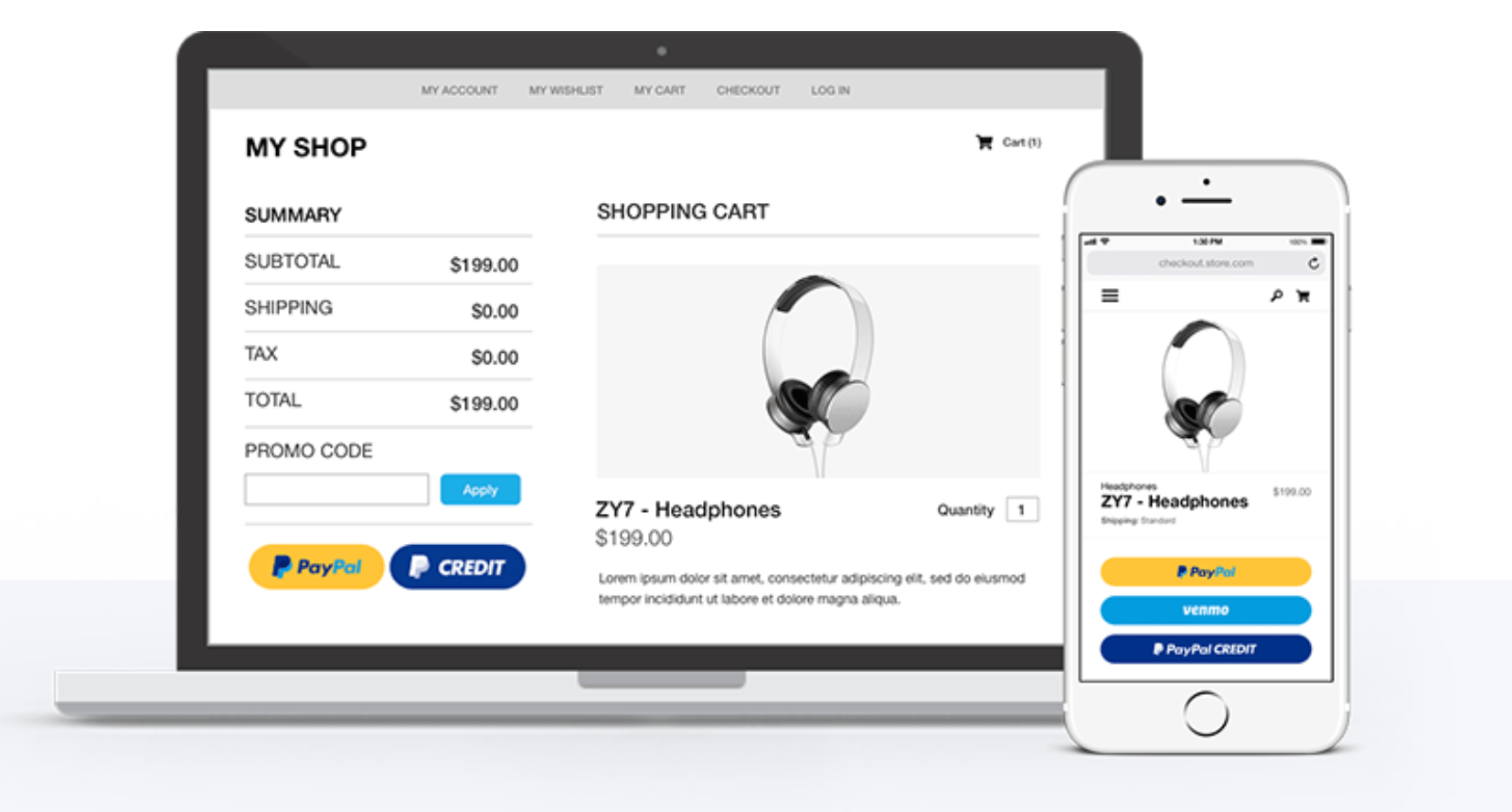
For those of you who already have an existing payment processor that you’re using to accept credit cards on your ecommerce site, PayPal Checkout might be a good option for you to consider.
Basically, you can just add the PayPal button to your current payments page with this supplemental plan. It’s easy to integrate with your existing ecommerce platform. Once the button is added, your customers will be able to use PayPal, PayPal credits, or Venmo to buy from your online store.
Conversion rates are up to 82% higher when PayPal Checkout is added to ecommerce sites. That’s because shoppers can complete the purchase in just a click or two, if they have PayPal on their phones or if they’re already logged into PayPal on their computers.
There is no setup fee or monthly fee for this plan. PayPal charges merchants 2.9% + $0.30 per transaction in the United States.
The PayPal Payments Standard plan is made for merchants who don’t have an existing payment processor or want to switch providers.
In addition to the PayPal payment options, you’ll also be able to accept Visa, Mastercard, American Express, and Discover cards. Adding the button to your website is as simple as copying and pasting some code. The checkout pages will be hosted by PayPal.
This plan will cost you 2.9% + $0.30 per US transaction. There are no monthly fees or setup fees for the Payments Standard plan.
Payments Pro is the top-tier plan offered by PayPal. It allows you to create a fully customizable checkout experience on your ecommerce site.
Unlike the Payments Standard plan, website visitors won’t have to leave your site to complete the checkout process. It also has a mobile-optimized checkout process and easy shopping cart integration. Payments Pro gives you a virtual terminal, which makes it possible to accept payments over the phone as well.
With the added features, this plan costs $30 per month, plus the standard 2.9% + $0.30 per transaction.
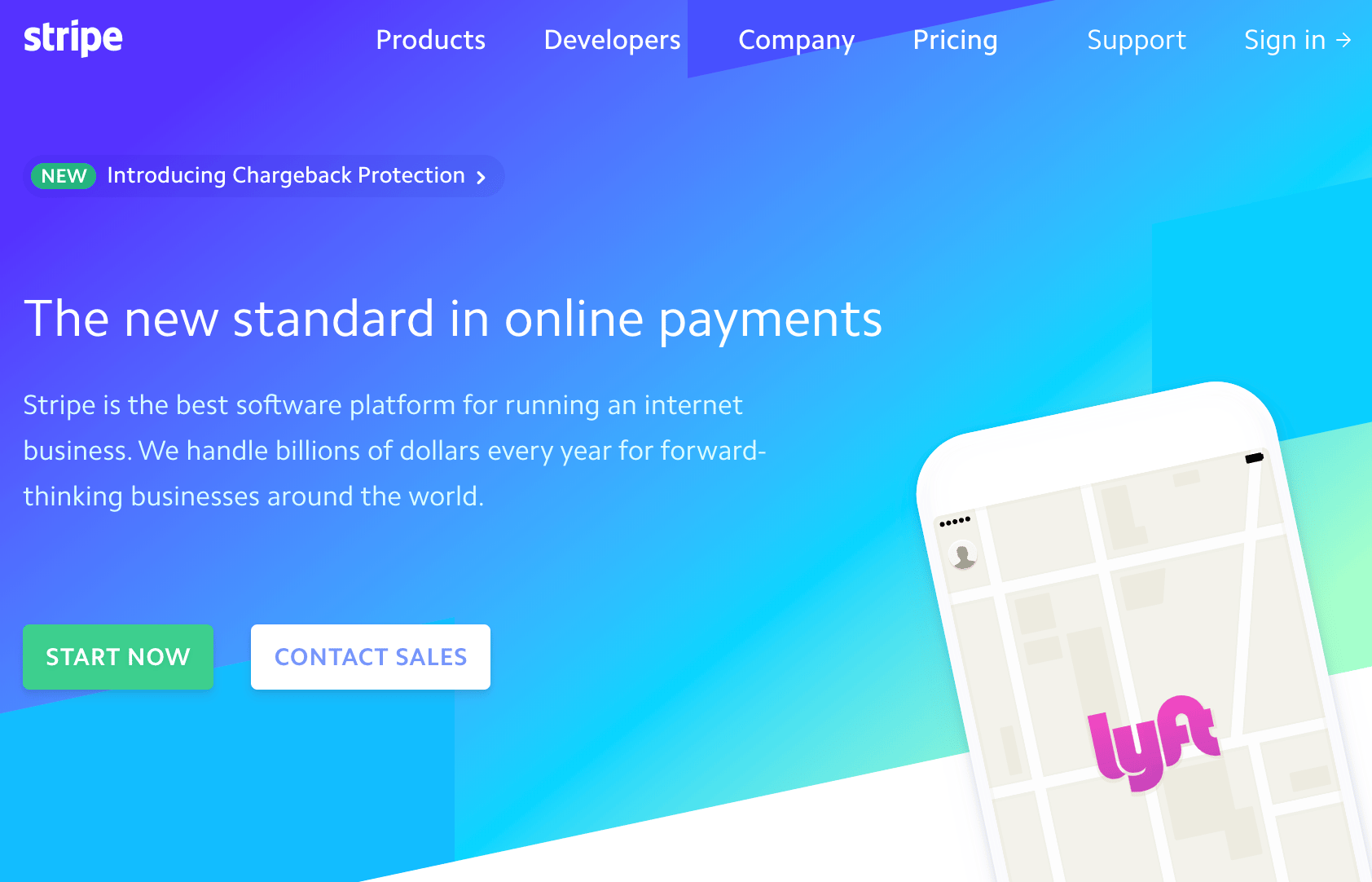
Unlike PayPal, Stripe doesn’t have their services segmented into tiered plans. Stripe’s payment processing will be the same, regardless of what features you’re taking advantage of.
With that said, depending on which tools you want to use, it will cost more. But the nice part about this is that you’re only going to be charged for the features that you actually want, as opposed to paying for a plan that includes tools you don’t need.
You can easily add Stripe to your ecommerce site with just one simple integration.
Once that happens, the platform makes it easy for you to accept payments, process them, settle, and reconcile. You’ll be able to process credit cards and ACH transfers both online and via mobile app payments. In fact, big mobile app brands like Lyft are already using Stripe.
Stripe lets you build a checkout process from scratch, or select one of their pre-built templates.
The platform has features for invoicing and setting up recurring payments for subscriptions as well. Let’s take a look at some of those add-on features I was talking about earlier.
Stripe Connect is made so that marketplaces and platforms can accept money and pay it out to third parties. It supports ecommerce sites, crowdfunding, on-demand businesses, and travel or event platforms.
Take advantage of Stripe’s UI components that are pre-built, or use their tools to create and customize everything on your own.
Sigma helps businesses analyze data from stripe using SQL. It can help improve the efficiency of business operations, finance departments, data teams, and product management.
It’s a great way for you to get to know your business better with data. Then you can make necessary adjustments based on your findings. Pricing for Stripe Sigma varies based on the volume of monthly charges.
Stripe Atlas is made for those of you who are starting an online business from scratch. The startup toolkit guides you through the process of forming a company, establishing IP ownership, filling out the right documents, and getting a tax ID number from the IRS.

Atlas also sets you up with a new bank account and debit card for your business.
There is a $500 one-time fee for using this service. Services like bank account maintenance, tax filing, and registered agents are not included in the setup fee. These are all billed individually at an annual rate.
Radar is Stripe’s fraud detection, prevention, and management tool. It’s designed to analyze your data and stop potential fraud cases before they are processed.
They take data from your checkout flows, payments, and financial partners to determine irregularities. Stripe’s partnership with major credit card companies and banks make it possible for them to identify fraudulent charges before you need to make a dispute.
Stripe Issuing is made for ecommerce businesses that want to create, distribute, and manage both physical and virtual cards for in-house purposes.
You can use these cards for things like employee expense accounts. It’s supported by Google Pay and Apple Pay as well. It’s also worth noting that Stripe Issuing is a beta program that’s only being offered in the United States.
For years, Stripe was better known for its online payment processing. But now they offer Stripe Terminal, which is a POS system for in-person payments.
This is a great option for those of you who have physical store locations in addition to your ecommerce shop. You can get everything you need both online and in-store from the same provider.
As you can see from everything that we’ve covered so far, these two payment service providers are very different from each other. But with that said, they have some things in common as well.
Deciding between PayPal and Stripe will mostly come down to personal preference and exactly what you’re looking for. Let’s take a look at some specific features to see how each platform stacks up against the other.
The pricing for PayPal is very straightforward. Only the Payments Pro plan has a monthly fee, while all three plans charge 2.9% + $0.30 per transaction.
Stripe also charges 2.9% + $0.30 per transaction. But they do have custom pricing packages for things like volume discounts and multi-product discounts, which can be useful for those of you who want to take advantage of the products we looked at earlier.
According to research Value Penguin, Stripe is more expensive than PayPal.
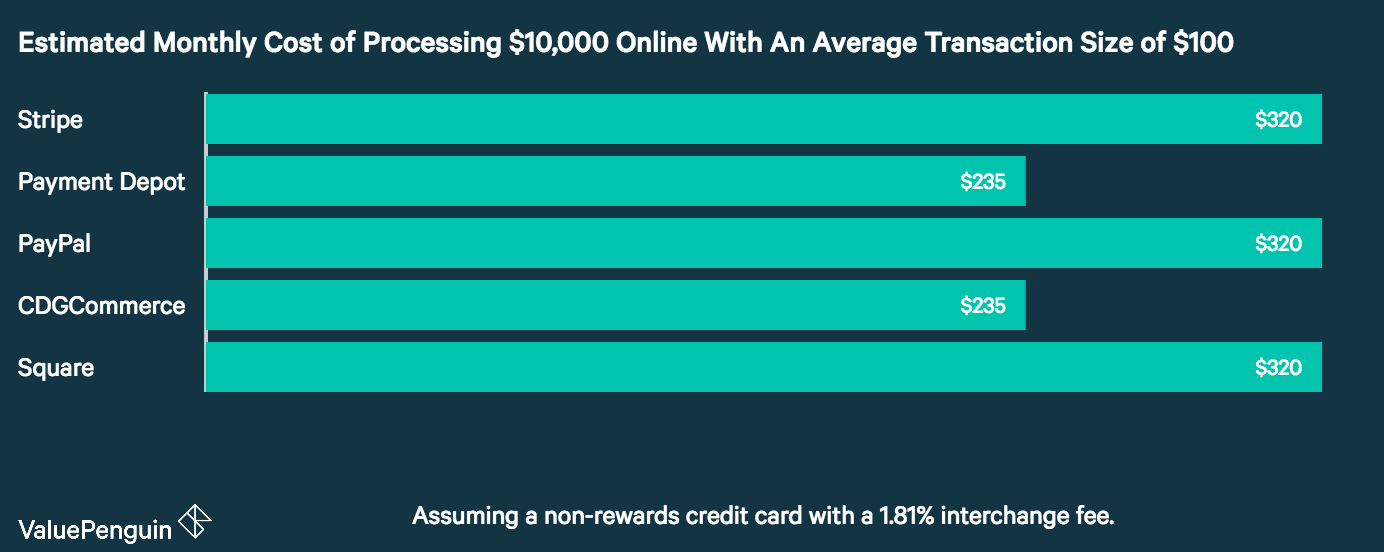
It can be argued that Stripe has more to offer, which might justify that higher amount. But when you compare the cost per transaction rates head to head, both services are even.
Both PayPal and Stripe offer excellent customer service and technical support options. They each have their own variation of a help center, with different tools, guides, FAQ, and resources needed to troubleshoot on your own.
You can also get help using:
Based on all of this, I don’t think that I can definitively say that one platform has better support than the other, so this category is a tie.
Stripe and PayPal are both easy to use. But with that said, Stripe is definitely more developer-friendly, meaning it could present more of a challenge to ecommerce store owners who don’t have that type of technical knowledge.
PayPal is as simple as copying and pasting some code to get set up, which is about as straightforward as it gets. So I’d say PayPal is better for beginners, while Stripe has more customizable options for developers.
Both PayPal and Stripe offer pay as you go contracts. So you won’t get locked into anything long term and can cancel at any time. You also won’t be charged a cancellation fee by either service if you decide to do so.
This category is another tie.
PayPal always had a reputation for its P2P payments through third-party platforms like eBay. Although now they’re taking aim at providing more services for ecommerce sites. Stripe has always been known for ecommerce solutions, but not offers POS solutions as well.
Both of these companies have the tools, services, and resources you need to run an ecommerce shop. They both have exceptional online reviews as well.
PayPal is the most popular digital wallet in the United States and is the most popular mobile payment method in North America. There are more than 277 million PayPal users worldwide.
Based on these numbers, I’d have to give the edge to PayPal in terms of reputation. But by no means am I saying that Stripe doesn’t have an excellent reputation as well.
If you have an ecommerce shop and you’re trying to figure out the best payment service provider, both PayPal and Stripe are top options to consider.
At the end of the day, it’s going to come down to personal preference. Based on the information I gave you above, you can decide which plan meets your needs the most.
I can’t definitively give an edge to one platform over the other. I’d strongly recommend both options.
For those of you who still aren’t sold on PayPal or Stripe, you can review my guide on the best payment methods for your ecommerce site to find some alternative solutions.
SEO by RankMath issued security updates to patch vulnerabilities and further improve security.
may Google puke with FCS networker
Here are seven SEO insights you can mine from your ticket log and help desk analytics.
Here are five steps that SEOs can take to become more resistant to Google algorithm updates.
how I went to number one on Google for a competitive term by just getting people to click my page
may Google puke with FCS networker
Here are four reasons why your videos might not be getting the search engine love they deserve.
may Google puke with FCS networker
In travel SEO, size isn’t everything. Here are seven ways to compete with big brands and come out on top.